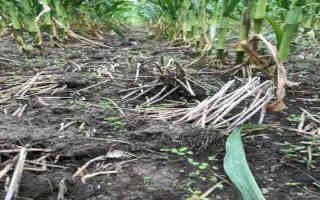By Meaghan Anderson and Prashant Jha
Recent rainfalls are likely to result in the establishment of winter annual weeds. Many fields may have dense stands of these weeds going into winter (Figure 1). It is often difficult to achieve timely burndown of these species in the spring, so farmers with persistent problems should consider making a fall burndown application to control winter annuals.

Figure 1. Henbit seedlings under a corn canopy on September 23, 2022 near Ames, IA.
Fall burndown applications may be beneficial in fields with a history of problems with winter annuals like horseweed (marestail), field pennycress, and henbit. The advantages of fall applications include more consistent control and less weed biomass the next spring that may interfere with planter operations. Consider the following before choosing this management option:
- Scout fields following harvest to determine whether winter annuals are present and if the weeds are exposed through residue cover. Waiting several weeks after harvest and re-scouting may allow residue to settle and weeds to grow through the cover. If most of the vegetation is covered by crop residue, it will be difficult to get sufficient coverage will a fall application.
- Some winter annual populations (e.g. marestail) may emerge both in the fall and spring, making effective control with a single herbicide treatment difficult. These populations may warrant a spring burndown rather than (or in addition to) a fall burndown.
- Follow herbicide label suggestions for carrier type, carrier volume, nozzle type, and environmental considerations. Treatments made on sunny days with warm daytime (>55F) and nighttime (>40 F) temperatures will generally be more successful than those made in cooler conditions. Winter annuals do not go dormant after a single hard freeze, so treatments can still be effective if milder conditions return.
- When selecting burndown treatments, consider the spectrum of winter annual and perennial species (e.g. dandelion) in the field. HG 91 (glyphosate) and HG 2 (ALS) resistant horseweed populations are widespread across the state. Including 0.5 lb. ae 2,4-D LVE or 0.25 lb. ae dicamba to glyphosate will increase the consistency of horseweed control, even in fields without glyphosate resistance. The addition of a residual herbicide in fall applications is not recommended due to the lack of consistent benefit and added expense. Residual herbicides are better left for spring herbicide applications, closer to the timeframe when most weed species are germinating.
Not all no-till fields require fall applications to control winter annuals. Situations that favor this tactic include: 1) history of high winter annual pressure, 2) presence of high weed densities at harvest, 3) presence of resistant biotypes that limit herbicide options in the spring, and 4) factors that prevent timely applications in the spring while weeds are small (poorly drained fields, sprayer availability, etc.).
Effective control of winter annuals prior to planting is an important first step for weed management in no-till, and in some fields, will benefit from a burndown application this fall. While fall-applied herbicides will reduce the amount of vegetation present next spring, they rarely eliminate the need for controlling established vegetation at planting.
1HG refers to herbicide group. The Group number refers to the site of action of a herbicide. The Group number is displayed on the first page of the herbicide label and is important information for developing resilient weed management programs less likely to select resistant weeds.
Source : iastate.edu